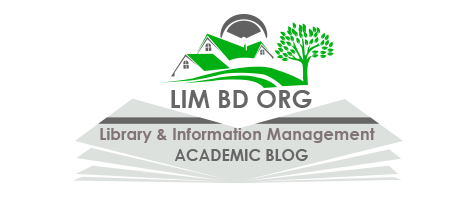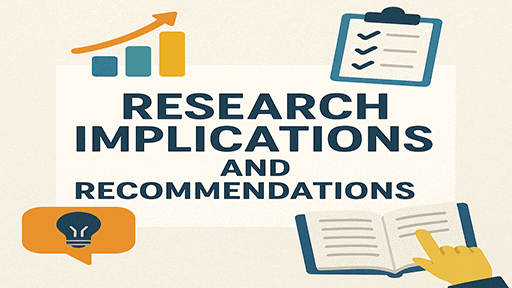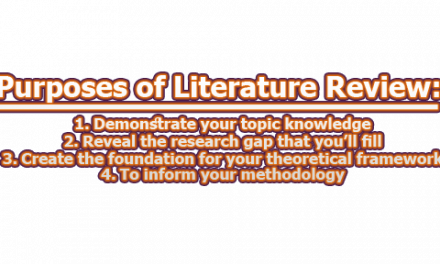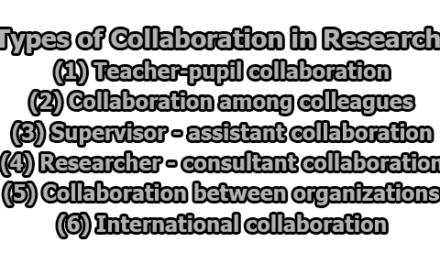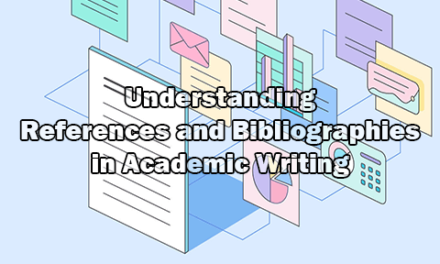Research Implications and Recommendations:
Research implications and recommendations are closely related but distinctly different concepts that often confuse students. In the rest of this article, we will explore research implications and recommendations and how to write them effectively.
In a research study, the implications and recommendations are two important sections that help explain the value of the results. Implications show what the study’s findings mean and how they might affect future research, real-world practice, or existing ideas and theories. In simple terms, they help answer the question, “Why are these findings important?” After that, the recommendations section gives suggestions for what should be done based on the study’s results. This part answers the question, “What actions should be taken?” These are practical steps that can help solve problems or improve current practices. In short, implications explain the meaning and impact of the study, while recommendations suggest specific actions to take. Both are closely linked to the study’s findings, but they serve different purposes—one focuses on understanding, and the other on action.
The Big 3 Categories of Research Implications:
After understanding what research implications are, it is important to explore the different types that commonly appear in academic work. Research implications generally fall into three main categories: theoretical implications, practical implications, and implications for future research. Each of these plays a unique role in showing how a study’s findings contribute to knowledge, practice, and further inquiry.
1. Theoretical Implications: Theoretical implications refer to how the results of a study support, extend, revise, or challenge existing theories. These implications are especially important in academic and scientific research, where knowledge is often built upon established theoretical frameworks. When a study’s findings align with or contradict previous theories, they may suggest a need to modify those theories or develop new ones.
For example, in the field of psychology, Bandura’s Social Learning Theory (1977) has been widely used to explain behavior. If a new study finds that people imitate behaviors not just through observation but also through virtual interactions, it may suggest that this theory needs to be updated to consider digital environments (Anderson et al., 2010). Such findings do not only contribute new knowledge but also push the boundaries of theoretical understanding.
2. Practical Implications: Practical implications deal with how the findings of a study can be applied in real-world settings. This includes areas such as education, healthcare, business, and public policy. These implications are particularly valuable to practitioners, decision-makers, and institutions that aim to solve problems or improve systems using evidence-based approaches.
For instance, a study by Hattie (2008) found that visible learning strategies, such as providing timely feedback and setting clear learning intentions, significantly improve student achievement. The practical implication here is that teachers and school leaders should consider implementing these strategies in classrooms to enhance learning outcomes. Similarly, in the field of public health, if a study reveals that plant-based diets reduce the risk of cardiovascular disease (Satija et al., 2017), policymakers may consider updating national dietary guidelines to reflect this evidence.
Practical implications can also influence policy and legal decisions. In criminology, for example, research showing the success of restorative justice programs in reducing recidivism has led to changes in how justice systems handle certain offenses (Latimer, Dowden, & Muise, 2005).
3. Implications for Future Research: Implications for future research focus on the knowledge gaps, unanswered questions, or unexpected findings that emerge from a study. These implications are essential for guiding future researchers toward new areas of investigation. They also acknowledge the limitations of a current study and propose ways to address them.
For example, if a study examining the effects of online learning finds inconsistent results among different age groups, it might suggest the need for further research that explores age-specific factors influencing online learning outcomes (Means et al., 2013). Similarly, if a study identifies a weak correlation between two variables where a strong one was expected, it may imply that there are moderating or mediating variables that future research should explore.
These types of implications are important because they help build a roadmap for continued exploration in the field. They ensure that research is a continuous, evolving process rather than a one-time event.
How to Write the Implications and Recommendations Sections:
Now that we’ve covered what research implications and recommendations are — and their different types — it’s time to look at how to write these sections effectively in your research document.
Where Do These Sections Belong?
Before discussing how to write them, it’s important to clarify where each section typically appears in a research paper or thesis.
- The implications usually form part of the discussion section. This is where the researcher interprets the findings in depth and considers their meaning in the wider academic or practical context.
- The recommendations usually appear in the conclusion. Here, the researcher offers specific suggestions or actions based on the results.
However, formats can vary depending on your field of study, institution, or even the type of report (e.g., a policy report vs. a dissertation). Therefore, it’s best to consult your department’s guidelines or speak to your supervisor to understand specific expectations.
How to Write the Implications Section:
The Implications section is a key part of your research paper, thesis, or dissertation. It allows you to explain what your findings mean, why they matter, and how they contribute to knowledge, practice, and future studies. It is typically included in the Discussion chapter. This section should move beyond simply summarizing results — it should show their broader significance and impact.
✅ Step 1: Understand the Purpose: Before writing, clarify what the implications section is for:
- To interpret the significance of your findings.
- To connect your results to theories, practices, or policies.
- To identify new questions or research gaps revealed by your study.
This section answers the question: “So what?” — What do these findings mean for the field, for professionals, and for future research?
✅ Step 2: Organize by Implication Type: Most high-quality implication sections are structured around three key categories:
- Theoretical Implications (Existing theories and literature)
- Practical Implications (Real-world applications and practices)
- Implications for Future Research (Future academic inquiry)
Using these categories will help keep your writing clear, focused, and logically organized.
✅ Step 3: Start with Theoretical Implications: This part explains how your findings relate to existing theories, models, or academic frameworks.
What to include:
- Do your results support or contradict established theories?
- Do they help refine or expand existing frameworks?
- Are you offering new conceptual insights?
Example sentence starters:
- “These findings contribute to existing theory by…”
- “The results confirm the theoretical model proposed by…”
- “Contrary to prior studies (e.g., Smith, 2020), this study suggests that…”
Tips:
- Cite past research to show how your results fit or challenge existing knowledge.
- Focus on significance, not just comparison.
✅ Step 4: Explain the Practical Implications: This part translates your findings into real-world applications. Think about how your research can be used in policy, professional practice, or daily operations.
What to include:
- How can organizations, practitioners, or policymakers use your findings?
- What decisions, tools, or strategies might be improved?
- Who benefits from the application of your results?
Example sentence starters:
- “The results have practical implications for [e.g., educators, managers, healthcare providers] in that…”
- “Implementing this approach could lead to improved outcomes in…”
- “The study suggests that organizations should consider revising…”
Tips:
- Be specific. Don’t just say “this is useful” — explain how and for whom.
- Mention any limitations in generalizability (e.g., geographic, cultural, or methodological).
✅ Step 5: Discuss Implications for Future Research: This section shows how your findings open new paths for scholarly work.
What to include:
- Gaps you uncovered.
- Unexpected findings that require deeper investigation.
- New questions raised by your data.
- Methodological suggestions for future studies.
Example sentence starters:
- “This study highlights the need for future research on…”
- “Given the mixed results, further studies should investigate…”
- “Future research may benefit from using [different sample, method, or theory]…”
Tips:
- Avoid generic statements like “more research is needed.” Be clear about what kind of research and why.
✅ Step 6: Use Clear, Precise, and Academic Language:
While the implications section is interpretive, it should still maintain formal academic tone. Use cautious, evidence-based wording.
Use verbs like:
- Suggests
- Indicates
- Demonstrates
- Supports
- Challenges
- Highlights
- Implies
Avoid:
- Overstating significance (e.g., “This proves that…”)
- Emotional or subjective language (e.g., “This amazing result shows…”)
- Vague terms (e.g., “Something should be done…”)
✅ Step 7: Link Back to Your Research Questions or Objectives: Each implication you write should connect clearly to your:
- Research questions
- Objectives
- Key findings
This keeps your discussion focused and relevant.
✅ Step 8: Keep it Concise but Meaningful: Implications should be thoughtful and evidence-driven, but not repetitive or overly long. Aim to:
- Group related ideas
- Focus on quality, not quantity
- Prioritize the most important implications
✅ Optional: Use Subheadings: If your thesis is long or your implications are complex, consider adding subheadings like:
- 1 Theoretical Implications
- 2 Practical Implications
- 3 Implications for Future Research
This makes the section easier to navigate and improves clarity.
✅ Summary Checklist:
| Element | Have you included it? ✅ |
| Theoretical contribution | ☐ |
| Practical value or application | ☐ |
| Suggestions for future research | ☐ |
| Connections to findings | ☐ |
| Clear, academic writing | ☐ |
| Avoided vague or exaggerated claims | ☐ |
How to Write the Recommendations Section:
The Recommendations section is where you translate the key findings of your study into clear, actionable suggestions for practice, policy, and future research. While the Implications section explains the significance of your findings, the Recommendations section answers the question: “What should be done next, and by whom?”
Purpose of the Recommendations Section: The recommendations section aims to:
- Provide specific and feasible actions that stakeholders can take based on your findings.
- Address the problems, gaps, or needs identified in your research.
- Suggest directions for future research to build upon your work.
- Offer practical improvements for systems, policies, or practices.
✅ Step 1: Review Your Key Findings: Before writing any recommendations, revisit the main results of your study. Focus on findings that:
- Expose a problem or gap.
- Show strong evidence for change.
- Suggest areas for development or further investigation.
Each recommendation should clearly stem from a specific finding in your research.
✅ Step 2: Identify Your Target Audience: Ask yourself: “Who needs to take action?”
This could include:
- Policymakers
- Institutions or organizations
- Professionals and practitioners
- Educators or administrators
- Researchers and academics
Tailor each recommendation to a specific group. This makes your suggestions more actionable and realistic.
✅ Step 3: Decide on a Structure: There are two main ways to organize your recommendations:
By Category or Theme: Group your suggestions under broad categories such as:
- Educational Recommendations
- Technological Recommendations
- Policy Recommendations
- Research Recommendations
By Stakeholder: Organize recommendations based on the audience who should take action, for example:
- Recommendations for Universities
- Recommendations for Government Agencies
- Recommendations for Future Researchers
Tip: Use clear subheadings to keep the section well-organized and easy to follow.
✅ Step 4: Write Clear, Action-Oriented Recommendations: Each recommendation should follow a basic structure:
Finding → Problem/Gaps → Recommended Action → Intended Outcome
Example:
- Finding: Many academic staff reported a lack of training in smart library systems.
- Recommendation: It is recommended that university administrations establish regular digital literacy workshops to train staff in using smart library tools.
- Intended Outcome: This will improve the effective adoption of smart technologies in library services.
Use sentence starters like:
- “It is recommended that…”
- “Based on the findings, [stakeholder] should…”
- “To improve [issue], it is advised that…”
- “In response to [finding], it is suggested that…”
Use strong action verbs:
- Implement
- Develop
- Increase
- Establish
- Improve
- Revise
- Expand
- collaborate
✅ Step 5: Make Recommendations Specific and Feasible: Avoid vague or overly ambitious suggestions. Instead, ensure your recommendations are:
| Criteria | Guiding Question |
| Specific | What exactly should be done? |
| Targeted | Who should do it? |
| Feasible | Can it realistically be implemented? |
| Relevant | Is it clearly based on your results? |
❌ “Policymakers should improve education.” (Too vague)
✅ “The Ministry of Education should revise the digital resource allocation policy to ensure rural schools have equal access to smart library infrastructure.” (Specific and targeted)
✅ Step 6: Include Recommendations for Future Research: Even if your study focuses on practical outcomes, it’s good academic practice to end your recommendations with suggestions for future research.
You might suggest:
- Replicating the study with a different population.
- Using alternative research methods.
- Exploring newly identified variables.
Example: “Future researchers should examine how smart library adoption affects academic performance among postgraduate students, as this was not covered in the current study.”
✅ Step 7: Use Formal and Academic Language: While your tone can be persuasive, maintain an objective, professional voice. Avoid personal opinions or emotional statements.
Use:
- “This study recommends…”
- “Based on the evidence, it is advised that…”
Avoid:
- “I think universities should…”
- “It would be nice if…”
✅ Step 8: Keep It Concise and Focused: Your recommendations section should be:
- Clear and straight to the point.
- Directly tied to your findings.
- Avoiding repetition from earlier sections.
If your study covered multiple themes, consider bullet points or numbered lists for readability.
Sample Template for a Recommendation Paragraph:
Based on the finding that [brief summary of the result], it is recommended that [specific action] be taken by [stakeholder group] in order to [desired outcome or improvement]. This recommendation addresses [problem or gap], and supports [evidence or rationale].
✅ Checklist for Your Recommendations Section:
| Requirement | ✓ |
| Directly based on key findings | |
| Addresses specific stakeholders | |
| Uses clear, actionable language | |
| Structured logically (by theme or audience) | |
| Includes feasible and realistic suggestions | |
| Suggests future research directions | |
| Maintains academic tone | |
| Avoids vague or generic advice |
In conclusion, understanding how to effectively communicate the implications and recommendations of your research is essential for demonstrating the value and impact of your study. The implications section highlights the broader significance of your findings, focusing on their theoretical contributions, practical applications, and relevance for future research. In contrast, the recommendations section translates these findings into concrete, actionable steps that relevant stakeholders can take to address identified issues or build upon your work.
Both sections should be clearly structured and grounded in your key results. The implications can be organized into three core categories: theoretical, practical, and future research. Similarly, your recommendations can follow the same structure or be grouped by target audience, such as policymakers, practitioners, or researchers.
Ultimately, a well-written implications and recommendations section not only strengthens your research but also enhances its usefulness in real-world settings. By clearly articulating what your findings mean and what should be done next, you contribute meaningfully to both academic discourse and practical improvement.
Frequently Asked Questions (FAQs):
How do I determine the implications of my study?
To identify your study’s implications, start by reflecting on how your findings relate to existing literature. Ask yourself:
- Do my results confirm, challenge, or expand current theories?
- Could these findings influence practice, policy, or professional guidelines?
- What are the broader social, economic, or cultural consequences of this work?
Revisiting your introduction and literature review sections can help you align your implications with the original research objectives and identified gaps.
Should I discuss both positive and negative implications?
Yes. Presenting both positive and negative implications offers a balanced perspective. While positive implications highlight the potential benefits and contributions of your study, negative implications acknowledge limitations, risks, or unintended consequences. This balance enhances the credibility and integrity of your research.
Can my research implications be speculative?
Yes and no. While implications are somewhat more speculative than recommendations and can suggest potential future outcomes, they should be grounded in your data and analysis. So, be careful to avoid overly speculative claims.
How do I formulate strong recommendations?
Your recommendations should stem directly from your findings, limitations, and implications. To formulate effective recommendations:
- Address specific issues or gaps identified in the research.
- Propose practical actions that stakeholders can realistically take.
- Suggest future research where necessary.
Use clear, direct language and make sure each recommendation is logically connected to your results.
How specific should my recommendations be?
Recommendations should be as specific and actionable as possible. Avoid vague suggestions like “more research is needed.” Instead, provide concrete guidance using the SMART framework: Specific, Measurable, Achievable, Relevant, and Time-bound.
Example: “It is recommended that university libraries conduct quarterly training workshops on smart library technologies to improve staff competence over the next academic year.”
Can I include recommendations for future research?
Absolutely. Identifying areas for future research is a key function of the recommendations section. These suggestions should naturally flow from the implications for future research you discussed earlier and focus on:
- Unanswered questions
- New variables or populations to study
- Methodological improvements
What if my findings were inconclusive – can I still write implications and recommendations?
Yes. Even inconclusive or mixed findings contribute to knowledge. In such cases, implications may focus on:
- The need for more rigorous or targeted research
- Methodological challenges
- Gaps or ambiguities in current understanding
Your recommendations could then highlight specific ways to improve future studies or suggest alternative research designs.
Should my recommendations align with the implications?
Yes. Your recommendations should logically follow from the implications. Think of it this way:
- Implications explain why your findings matter.
- Recommendations explain what should be done about it.
They are interconnected but serve distinct purposes.
Can I tailor recommendations to different stakeholders?
Yes, and in many cases, you should. Different audiences—such as policymakers, practitioners, researchers, or institutions—may benefit from different types of guidance. Organizing your recommendations by stakeholder can make your findings more accessible and actionable.
Where do the implications and recommendations sections go in a thesis or dissertation?
- Implications are typically included in the Discussion chapter.
- Recommendations are often presented in the Conclusion chapter.
However, the structure can vary depending on your university’s guidelines, so it’s always best to consult your department’s formatting requirements.
References:
- Anderson, C. A., Shibuya, A., Ihori, N., Swing, E. L., Bushman, B. J., Sakamoto, A., Rothstein, H. R., & Saleem, M. (2010). Violent video game effects on aggression, empathy, and prosocial behavior in Eastern and Western countries: A meta-analytic review. Psychological Bulletin, 136(2), 151–173. https://doi.org/10.1037/a0018251
- Armstrong, N. (2008). Book Review: Keith F. Punch. Developing Effective Research Proposals, 2nd edn. London: SAGE, 2006, £19.99 pbk (ISBN: 1 4129 2126 0), ix+164 pp. Sociology, 42(5), 1031-1032. https://doi.org/10.1177/00380385080420051402
- Bandura, A. (1977). Social learning theory. Prentice-Hall.
- Bloomberg, L.D. and Volpe, M. (2018). Completing Your Qualitative Dissertation: A Road Map from Beginning to End. 4th Edition, Sage, Los Angeles, CA.
- Creswell, J.W. and Creswell, J.D. (2018). Research Design: Qualitative, Quantitative, and Mixed Methods Approaches. Sage, Los Angeles.
- Hattie, J. (2008). Visible learning: A synthesis of over 800 meta analyses related to achievement. New York: Routledge.
- Latimer, J., Dowden, C., & Muise, D. (2005). The Effectiveness of Restorative Justice Practices: A Meta-Analysis. The Prison Journal, 85(2), 127-144. https://doi.org/10.1177/0032885505276969
- Locke, L. F., Silverman, S. J., & Spirduso, W. W. (2010). Reading and understanding research (3rd ed.). SAGE Publications.
- Means, B., Toyama, Y., Murphy, R.F. and Baki, M. (2013) The Effectiveness of Online and Blended Learning: A Meta-Analysis of the Empirical Literature. Teachers College Record, 115, 1-47. http://www.sri.com/sites/default/files/publications/effectiveness_of_online_and_blended_learning.pdf
- Miles, M.B., Huberman, A.M. and Saldana, J. (2014). Qualitative Data Analysis: A Methods Sourcebook. Sage, London.
- Satija, A., Bhupathiraju, S. N., Spiegelman, D., Chiuve, S. E., Manson, J. E., Willett, W. C., & Hu, F. B. (2016). Healthful and unhealthful plant-based diets and the risk of coronary heart disease in U.S. adults. Journal of the American College of Cardiology, 70(4), 411–422. https://doi.org/10.1016/j.jacc.2017.05.047
- Thomas, G. (2017). How to Do Your Research Project: A Guide for Students. Sage, London.

Library Lecturer at Nurul Amin Degree College
